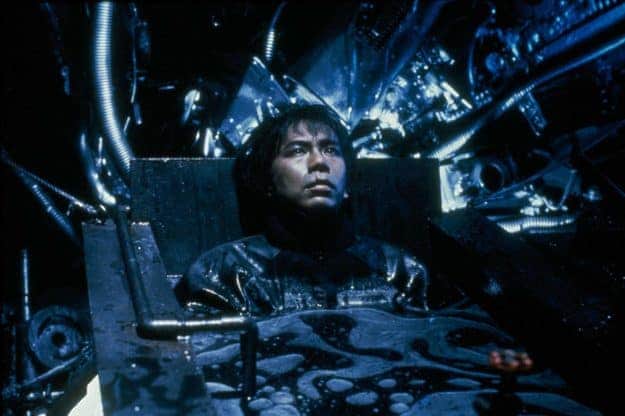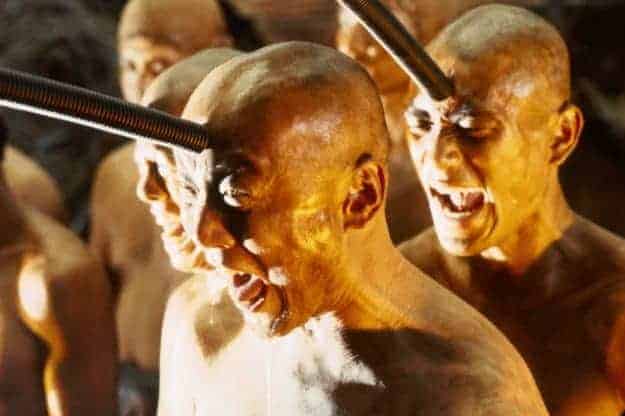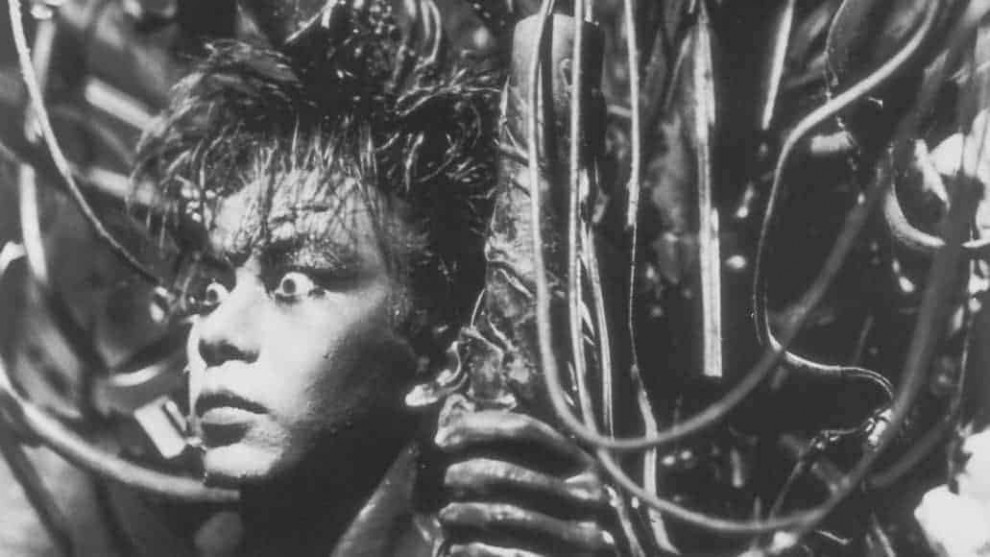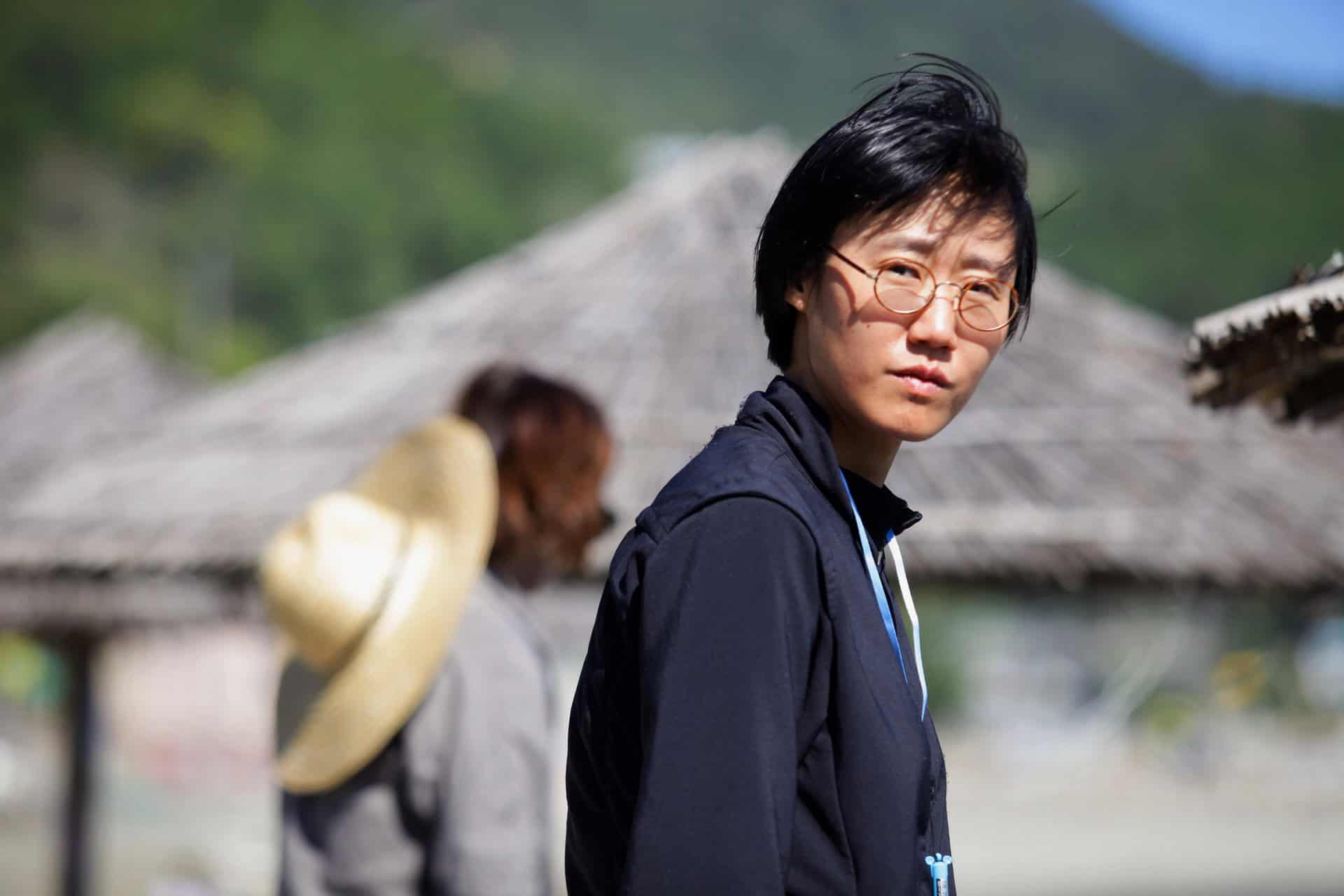By Jaim Cleeland
This essay will examine how the male body is portrayed in Tetsuo: Iron Man (Dir. Tsukamoto, S., 1989) and Tetsuo II: Body Hammer (Dir. Tsukamoto, S., 1992). The two films present an alternative response to mainstream Japanese cinema in the late 1980s and early 1990s. Both films can be viewed as queering traditional heteronormative Japanese masculine identity. Not since the essay Daraku-ron (An Invitation to Total Depravity) and the novel Nippon Apache-Zoko, had Japanese been depicted “as subhumans” (Sato, 2004, p.347 – 348). Which brings forth the question, does Tsukamoto's characters in his two films represent the subhuman or uber maschine mensch?
Buy This Title
In an early scene in Tetsuo: Iron Man the viewer sees a series of photographs of male athletes. The photographs have been placed on the ground in an industrial yard and are framed by metal and scrap iron. It is a space which can be viewed as dirty, and where broken machinery ends up. The photographs signify the male athletes' persona, healthy, one of fantasy, the perfect machine and myth. In contrast is the film's antagonist Metal Fetishist who, in an act of self-mutilation, forces a metal rod into his leg. The sequence ends with a close up that shows the photographs burning, suggesting further destruction will follow.
In the next scene, Metal Fetishist is seen running along a road. His running style mimics that of an athlete. He is then knocked down by a car driven by the film's protagonist Salaryman who is with his girlfriend. Later, when Salaryman is in his home shaving, he notices a metal hair on his cheek. Talking on the phone with his girlfriend who asks him “Are you okay?” (Tetsuo: Iron Man) she continues by saying “ever since… I have felt very strange” (Tetsuo: Iron Man). After the hit-and-run accident involving Metal Fetishist, they had driven off and the scene ends with a point of view shot from Metal Fetishist watching the couple having sex in the countryside. The girlfriend's comments suggest a feeling of guilt about the outdoor sex or for not having taken care of Metal Fetishist or possibly both. The countryside also offers the viewer another reading. It functions as a border between the agrarian countryside where everything is in harmony and the post-industrial city where self and other are in conflict.
In the subway station scene Salaryman looks anxious. He is sweating and trying to loosen his collar. His white shirt, black tie, black suit and shoes offer no real clues to his individuality. Tsukamoto's framing places him in isolation from the other suited droves of Samarai-salarymen coming and going to work. They appear as a background blur of coats and brief cases.

Salaryman sits down next to a woman who instantly inches away from him. She looks down by her feet and sees a smouldering bug-like clump of metal and leans towards it and pokes it with her pen. The shot cuts to the point of view from the view of the breathing, bug-like clump of metal. Inside this metal clump is a freakish alien male-body hammering away. It breathes heavily as she inserts her pen into it. The Salaryman sees the woman now has the bug-like clump of metal in her lap and is clearly bringing it to some sort of alien erotic climax. The woman then undergoes a metamorphoses, the metal clump becomes attached to her arm.
Salaryman, still sweating, clutching his briefcase runs away. Although he has experienced similar changes within himself, he views her as only a monster. The idea of her being a monster, something alien to himself is entwined in the mechanization of Japanese society in the 1980s onwards. It was a time when the interpenetration of machinery and globalisation was becoming a common aspect in people's lives and homes. The flow “of people, goods, money, ideas, images – move between borders – of nations, economies, cultures” (Allison, 2001, p.241) and made this an age of deterritorialization. Things like phones, answering machines, Walkman, video recorders, television and computers had become part of everyday use.
One possible reading of the monsters that are presented on screen is that they parallel an off screen devouring monster. Which was the West's capitalist consumerist influences on the mid 1980s Japanese culture.
In a later scene Salaryman dreams his girlfriend is wearing a huge giant metal phallus that moves in a snake-like manner. In this dream her body movements are exaggerated and exotic. She is the object of Salaryman's gaze. The viewer sees her from Salaryman's perspective. He is on all fours, naked. Gender roles are subverted as she mounts and penetrates him from behind with her giant metal phallus.
He wakes up sweating next to his girlfriend. Moments later he and she are grinding against each other when he has his first major bodily change. Between his legs is a big vicious looking rotating drill that breaks through the table. Salaryman tries to scurry away from his girlfriend and hide in the bathroom. He believes that he is being punished. He eventually emerges from the bathroom having gone through both emotional and physical changes. In the bathroom he had simultaneously progressed and regressed through metal. What emerges from the bathroom points towards his failure as a human, by not being able to control inside and outside forces. At first the changes that occur show him as being ashamed of his appearance. This series of shots draws parallels to the cultural crisis of male-shame within 1980s Japan. A time when there was a rise of male unemployment and young women were becoming high earners and less inclined to marry. This was the first Japanese post World War II male-generation that had to adapt towards these societal changes.

Tsukamoto's own Japaneseness as both the films' director and as a male living and growing up in Japan, is an important factor to consider when viewing either of the Tetsuo films. It is his Japaneseness that both plays with and at the same time challenges the Orientalists' take on the ascribed image of Japanese men. According to Miyao: “American people have identified Japanese men with a complex Orientalist image that involves an ambiguous masculinity” (Miyao, D., 1998, p.70).
Salaryman in a state of ecstasy accidentally kills his girlfriend by drilling her to death with his phallus. He places her body in the bathtub. He later revives her by secreting fluid into her mouth via a metal pipe from his mouth.
Salaryman's changes no longer just question his own existence. The metamorphoses also begins a flow of external information into the outside landscape where the postmodern collides with modernity.
Salaryman overcomes both neurological and psychological constraints to be free from his human body, though this does not free him from the heteronormative traits of his gender, such as being: aggressive, sexually aggressive, competitive and non-emotional. This suggests that Salaryman's colonized body is not liberated by the changes that take place. His changes do not point towards a post-biological world that will be dominated by any intellectual self-improving. Schaub's alternative reading suggests that the film's narrative shows that the fragmentation of Salaryman's character “is far from being a lament for this loss. It is closer to being a celebration of new possibilities” (Schaub, 2001, p.88).
At first the difference between Metal Fetishist and Salaryman is that Metal Fetishist is seen as a grotesque post-industrial Frankenstein monster metaphorically caged in by machinery. Metal Fetishist inhabits a posthuman netherworld where his body acts within both the metaphysical and physical realms.
He has telepathic powers that enable him to link and communicate with Salaryman and his girlfriend. The scope of Metal Fetish's full powers allow his physical body to pass through physical borders and take over other peoples bodies. It is he in the woman's body in the subway station and it is he in the Salaryman's body and the girlfriend's body. With Metal Fetishist there is a nihilistic self-torturing acceptance of metal parts into his flesh. The savage penetration of his outward body with metal can be read as an act of rebellion against both the heteronormative community and the Japanese ruling intellectual force. It can also be read as a subversive reaction and as a reflection of the historical relationship between Japan and the American forces after World War II. Those occupying forces administered change by putting into place mechanisms such as the Potsdam Declaration, breaking up Japanese business conglomerates, and downgrading of the Japanese Emperor. These changes were attempts to bind Japan to Western capitalism.
The Metal Fetishist's body welcomes change. The idea of a futuristic body parallels the emergence of cyberspace technology, the World Wide Web which in the beginning embraced and enabled invisibility and anonymity as building blocks to the future. In this future Metal Fetishist's victims lose control of their bodies.
The initial loss of control that Salaryman experiences represents a direct attack on his male ego. His idealizations and dreams can never be fully achieved. His metamorphoses also draws parallels with “karaoshi […] death from overwork” (Davies & Ikeno, 2002, p.88) which was something that was on the rise in mid 1980s Japan.
In contrast to Metal Fetishist's futuristic body, Salaryman plays against the conventions of the stereotypical images of the future. His stage is the Tokyo suburbs, rather than futuristic vertical style cities inhabited by cyborgs.
In both Tetsuo films the viewer sees living people getting embalmed in metals and irons. In ancient Egypt the practice of embalming the dead was used to stem the flow of time.
In Tetsuo: Iron Man a modern interpretation of embalming does not stop at the gates of time. It allows for the body to overcome modernity. The death of humanity propels an upgrade to a world inhabited by cyborgs and new ways in which to view oneself. It is also a place where no God can dwell within the body. Stelarc suggests it could well be that the “significance of the cyber may well reside in the act of the body shedding its skin” (Stelarc, 1998, p.116).
At the end of Tetsuo: Iron Man the borders between his home and the outside world have dissolved. His body has fully merged with Metal Fetishist into spectacle, an amalgamation of weaponry and “a gigantic engine, ready to go for the world.” (Herogenrath, 2003, p.60).

In Tetsuo: Body Hammer the antagonist is again a metal fetishist who has superhuman qualities enabling him to shoot people by pointing his hand.
The protagonist is Salaryman, who at first appears to be wimpish, unable to protect either himself or his family. At the gym his wife reminds him “He needs to get strong” (Tetsuo: Body Hammer). As he tries to the lift the weights he fantasizes of a strong, Sylvester Stallone type body. On the roof of a tower block he is beaten and left hanging over the edge. When he finally pulls himself to safety, his anger gets the better of him and his arm mutates in to a gun. He attempts to shoot his attacker, though instead shoots his son by mistake.
The idea of a man having to be the strong “hard-body” protector is tied up with the 1980s and early 1990s. The period of Reaganism, where “toughness, strength” (Jefford, 1994) were to be seen as “'good old Americaness'” and where Hollywood action movies perpetuated this myth with films such as First Blood (Dir. Kotcheff, T., 1982) and Lethal Weapon (Dir. Donner, R., 1987).
In a later scene hyper masculine, shaven-headed Asian body builders are working out in a hell-like place with fires burning. There is an overall sameness in their appearance and actions. They pump iron and are watched over by a mad scientist. Salaryman is taken to this place and strapped to a chair on a raised platform. He is then forced by the mad scientist to watch calming images which cause an aversion reaction. There is a shot of the body builders looking up at him in awe as if he were a God. Salaryman is able to change at will into a metal monster and a gun emerges from his chest. The bodybuilders need the help of the mad scientist.

Near the very end of the film the each of the body builders is attached by a tube to his forehead with Salaryman who has lost all humaness. The body builders stand screaming, though it is left to the viewers imagination as to what they are seeing.
Both films sabotage the established belief in machinery. Machinery is dismantled first then magnetically drawn towards its characters where it fixes itself to them. Another question that is repeated throughout the two films is whether the loss of humanness will inevitably accompany an increasingly technologized world. The films also point to the fact there are direct casualties to industrialization.
Throughout both films Salaryman's body is a battleground where continual invasions and (re)inventions by mechanical alteration erode his human identity.
The final scene in Tetsuo: Body Hammer sees Salaryman victorious. He is fully mutated into a tank, no longer ordinary and no longer puny.
Filmography:
First Blood, (1982), Ted Kotcheff, Dir.
Lethal Weapon, (1987), Richard Donner, Dir.
Tetsuo: Iron Man, (1989), Shinya Tsukamoto, Dir.
Tetsuo: Body Hammer, (1992), Shinya Tsukamoto, Dir.
Bibliography:
Allison, Anne, (May, 2001), Cyborg Violence: Bursting Borders and Bodies with Queer Machines, Cultural Anthropology, Vol. 16, No. 2, pp. 237-265
Broadhurst Dixon, Joan & Cassidy, Eric, J., (Ed.), (1998), Virtual Futures: Cyberotics, Technology and Post-Human Pragmatism, Routledge
Davies, Roger & Ikeno, Osamu, (2002), The Japanese Mind: Understanding Contemporary Japanese Culture, Tuttle Publishing
Komatsu, Sakyo, (1964), Nippon Apache-Zoku (Publisher UNKNOWN)
Miyao, Daisuke, (1998), Doubleness: American Images of Japanese Men in Silent Spy Films
Sakaguchi, Ango, (1946), Daraku-ron (Publisher UNKNOWN)
Sato, Kumiko, (2004), How Information Technology Has (Not) Changed Feminism and Japanism: Cyberpunk in the Japanese Context, Comparative Literature Studies, Volume 41, Number 3, p.335 – 355 Published by Penn State University Press
Schaub, Joseph Christopher, (2001), Asian Journal of Communication, Volume 11, Number 2
Tomasulo, Frank, P. (Review by), (Autumn 1995), Hard Bodies: Hollywood Masculinity in the Reagan Era by Susan Jeffords, Film Quarterly, Vol. 49, No. 1, pp. 47-49, Published by: University of California Press
















